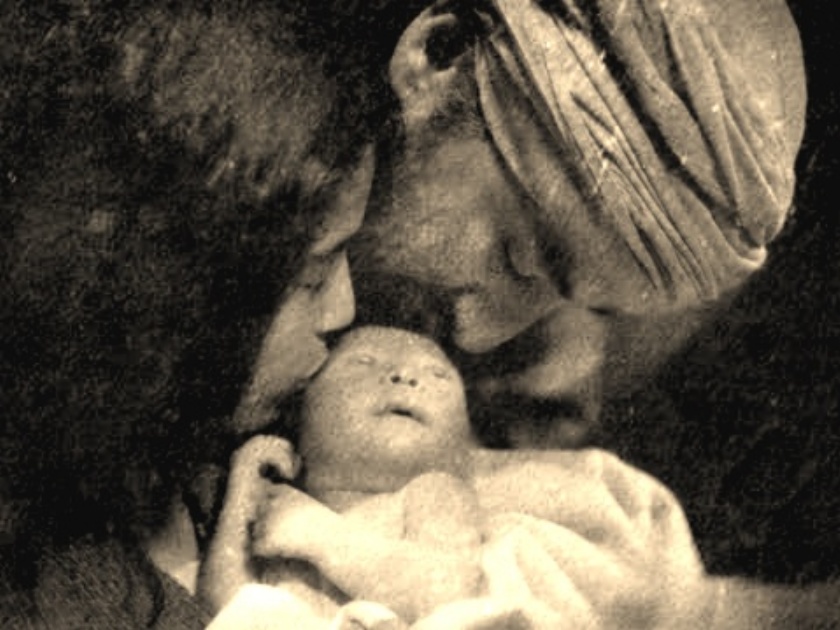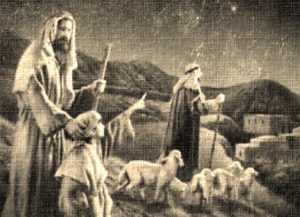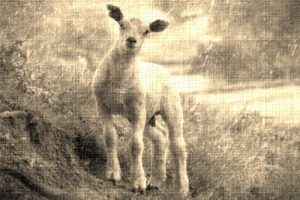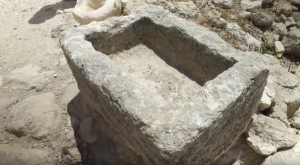The name of the Messiah is Yeshua, a common alternative of the name Yehoshua (יהושע), which means ‘Yah is salvation’ [Matthew 1:21]

Who were the shepherds of Bethlehem that greeted Yeshua at the time of his birth?
What were the lambs born in Bethlehem used for?
When was Yeshua really born?
The birth of Yeshua was foretold to take place in Bethlehem by the prophet Micah
Micah 5:2 [The Scriptures - TS] 2 But you, Beyth Lehem Ephrathah{fruitful place}, you who are little among the clans of Yehudah {Judah}, out of you shall come forth to Me the One to become Ruler in Yisra’el. And His comings forth are of old, from everlasting.
Bethlehem was a small Jewish town 6 miles or 9.6 kilometres from Jerusalem. The name «Beit Lechem» means ‘House of Bread’ and «Ephrathah» fruitful. Yeshua the Living Bread was born in the House of Bread
John 6:51
51 I am the living bread which came down out of the heaven
[Yeshua's words in purple]
Bethlehem most probably had a population of fewer than a thousand people, perhaps only a few hundred in Yeshua’s day. It was prophesied that he would be a descendant of David, the shepherd king who was also born in Bethlehem around a thousand years prior to Yeshua (for more information see THE BIRTH OF YESHUA )
What makes Bethlehem so unique, aside from being Yeshua’s birthplace, is the fact that the lambs born and raised in Bethlehem were used for the temple sacrifices, according to rabbinic writings. The hills around Bethlehem were home to the hundreds of lambs used in ritual worship at the Temple.
The daily Temple sacrifice required two unblemished sheep from Bethlehem. One sacrificed in the morning and one in the evening as a continual sacrifice before the Eternal. One year old lambs were also needed during Passover and other festivals.

THE SHEPHERD-PRIESTS
The shepherds in charge of these special lambs were from the tribe of Levi. They were Levitical shepherds (shepherd-priests). Their job was to raise animals that were healthy and without blemish and pure enough for the temple sacrifices as stated in the Eternal’s instructions in the book of Leviticus. Who better than these shepherd-priests to welcome the ‘Lamb of the Eternal’.
Every firstborn male lamb from the area around Bethlehem was considered holy, set aside for sacrifice in Jerusalem. Generations of hereditary shepherds tended the sacred flocks. 
Once the lambs were of age, the shepherds would take them to Jerusalem for the temple sacrifices. It was important that the lambs that were to be sacrificed did not have any blemishes (broken legs, or injuries). After the lamb was born it was wrapped in swaddling cloths (strips of cloth were taken from priests’ old clothes) to keep it protected without spot or blemish (the Scripture requirement for a perfect lamb), and then this lamb would be laid in a manger until it had calmed down and to protect it from being trampled.
At the time of the Feast of Passover the lambs to be sacrificed had to be one year old and without blemish, this means they were born on or around the Passover season. Once the lamb’s blood was completely spilled for all of the sins, the priest would turn to the people and proclaim, “It is finished” or “it is accomplished”. Yeshua also pronounced these same words once His blood was spilled.
John 19:30 [TS] So when יהושע{Yehoshua} took the sour wine He said, “It has been accomplished" {it is finished}! Yeshua's words in purple
MIGDAL EDER [The Tower of the Flock]
Micah 4:8 [ERV]
8 And you, Tower of Flocks, your time will come. Ophel, hill of Zion, you will again have the right to rule. Yes, the kingdom will be in Jerusalem as it was in the past.

Migdal Eder was a tower used from ancient times by the Levitical shepherds to protect their sheep and lambs from enemies and from wild beasts. On the ground floor, a room was designated for the delivery and protection of these special lambs. Ewes were brought there to give birth to the lambs. Here they kept a place that was ceremonially clean for the ewes to lamb. It was a place fit for the Lamb of the Eternal to be born.
The tower of the flock was built of stones, does not exist today and archaeology has not found its ruins as of yet. However, based on biblical record (Micah 4:8) and other evidence we must conclude that Yeshua was not born a dirty stable of an inn where donkeys and other animals were kept.
Alfred Edersheim wrote:
“And yet Jewish tradition may here prove both illustrative and helpful. That the Messiah was to be born in Bethlehem, was a settled conviction.
Equally so, was the belief that He was to be revealed from Migdal Eder, ‘the tower of the flock.’ This Migdal Eder was not the watchtower for the ordinary flocks which pastured on the barren sheep ground beyond Bethlehem, but lay close to the town, on the road to Jerusalem.
A passage in the Mishnah leads to the conclusion, that the flocks, which pastured there, were destined for Temple-sacrifices, and, accordingly, that the shepherds, who watched over them, were not ordinary shepherds.
The latter were under the ban of Rabbinism, on account of their necessary isolation from religious ordinances, and their manner of life, which rendered strict legal observance unlikely, if not absolutely impossible.
The same Mishnaic passage also leads us to infer, that these flocks lay out all the year-round since they are spoken of as in the fields thirty days before Passover–that is, in the month of February, when in Palestine [Israel] the average rainfall is nearly greatest.
Thus, Jewish tradition in some dim manner apprehended the first revelation of the Messiah from that Migdal Eder, where shepherds watched the Temple-flocks all the year-round. Of the deep symbolic significance of such a coincidence, it is needless to speak.
[Alfred Edersheim – The Life and Times of Jesus Messiah (1899)]
Summary: There was a place just outside of the town of Bethlehem, but still within the region commonly known as Bethlehem, where Passover lambs were kept by specially trained and purified shepherds. The lambs were born in this “Tower of the Flock” known as «Migdal Eder» under the watchful eye of the shepherd priests who would then inspect and certify them for use as sacrifices in the temple or designate them to be released for common use. The new lambs would, according to some sources, be wrapped in special swaddling clothes once certified.
THE SIGN IN THE ANGEL’S MESSAGE
Luke 2:12 12 And this is the sign to you: You will find a Babe wrapped in swaddling cloths, lying in a manger.
The angel gives the shepherds a sign with two parts:
1) wrapped in swaddling cloths
2) lying in a manger

A baby <wrapped in swaddling cloths> was not unusual in first-century Israel. When a baby was born, the umbilical cord was cut and tied; then the baby was washed and rubbed with salt and oil, and wrapped with strips of cloth. These strips ensured that the child was warm and that his limbs would grow straight. This part of the sign was not enough on its own because any new-born baby would be wrapped in swaddling cloths.
<Lying in a manger> – was the second part of the sign and that made this baby unique because new-born babies were not normally put in a manger [feeding trough]. New-born lambs were put in a manger after swaddling them to keep them from being trampled and to keep them calm. The new-born Lamb of the Eternal was like-wise swaddled and put in a manger.
There is an interesting clue in the Greek Interlinear Bible
Luke 2:12 [Scrivener’s Textus Receptus – AV]
καιG2532 AND τουτοG5124 THIS "IS" υμινG5213 TO YOU τοG3588 THE σημειονG4592 SIGN : ευρησετεG2147 [G5692] YE SHALL FIND βρεφοςG1025 A BABE εσπαργανωμενονG4683 [G5772] WRAPPED IN SWADDLING CLOTHES, κειμενονG2749 [G5740] LYING ενG1722 IN τηG3588 THE φατνηG5336 MANGER. "
Other versions with lying in the manger:
• Restored Holy Bible [RHB] – lying in the manger
• Hebrew Roots Bible [HRB] – lying in the manger
• Literal Translation [LITV] – lying in the manger
• Literal Standard Version [LSV] – lying in the manger
• Young’s Literal Translation [YLT] – Lying in the manger
Micah 4:8 [ECB] 8 And you, O Migdal Eder, the mound of the daughter of Siyon, to you it comes - even the first reign; the sovereigndom comes to the daughter of Yeru Shalem.
Typically, «Migdal Eder», at Bethlehem is the perfect place for Yeshua the Messiah to be born. He was born in the very birthplace of tens of thousands of lambs, which had been sacrificed to prefigure Him, the Lamb of the Eternal.
WHEN WAS YESHUA THE MESSIAH BORN?
The Scriptures tell us that the shepherds were outside watching the sheep at night
Luke 2:8 8 And in the same country there were shepherds living out in the fields, keeping watch over their flock by night.
The following are clues that will help us pinpoint when Yeshua was born
The Season Clue:
Unlike humans, sheep have a season for giving birth. The lambing season in first-century Israel, due to the existing breed of sheep then, occurred from late March to mid-April. Shepherds would typically only watch flocks in the open at night during the lambing season. December would have been too cold and probably too rainy for the shepherds to be out at night watching their flocks.
Yeshua is the Lamb of the Eternal so, who better than the shepherds to welcome him at birth. The census required families to travel back to their father’s town of origin. Joseph belonged to the family of David, which is why they were in Bethlehem that night. The Romans would not have called for a census during winter as it would have been very hard for the people to travel long distances in the cold and rain. So the December birth date is, at the very least, doubtful.
Some scholars believe that it is more likely that Yeshua was born in the autumn festival of the Feast of Tabernacles but there is a problem with this theory because all males had to be in Jerusalem for this Festival, as specified in the Torah. The birth of Messiah would not cause Joseph to break the law of the Eternal by being outside of Jerusalem during the Feast of Tabernacles.
The Age of the Lambs Clue:
Exodus 12:5
5 Let the lamb be a perfect one, a year old male
If the lambs were one year old at the time they were sacrificed during Passover that means they would have been born at around the same time a year before, that is, in the Spring, during the lambing season.
Yeshua, who was the fulfilment of the foreshadowing of the sacrificial lambs, was also sacrificed during the Passover so it follows that he would have been born around the same season in springtime. Yeshua was born around the Passover season.
The Festivals of the Eternal Clue: [see THE MASTER PLAN OF YAHWEH for more information]
Every important event in Yeshua’s life corresponds to a Festival or day commanded by the Eternal. So an event as important as his birth would have to coincide with a Festival as well. The Eternal יהוה is an Elohim of order. It would have to be a Spring Festival as everything would have to be in order. First His birth, then His death, resurrection, etc…
The Eternal commands us to begin the year and everything on the first day of the month of Nissan
Exodus 12:1-2 [TS] 1 And יהוה spoke to Mosheh{Moses} and to Aharon{Aaron} in the land of Mitsrayim{Egypt}, saying, 2 “This month is the beginning of months for you, it is the first month of the year for you.
– He was born on the beginning of the Hebrew year.
– He died on Passover – when the sacrificial lambs were sacrificed.
– Then came the Feast of Unleavened bread (leaven symbolises sin). Yeshua lay in the tomb after living a life without sin.
– He resurrected on the Feast of First-fruits – when Israel offered the first fruits of the land to the Eternal. He was the Eternal’s First-fruit, the First of many to be resurrected.
– He sent the Set-Apart Spirit to his disciples on «Shavout» (Pentecost).
In the writings of Hippolytus, early church father (ca. 170-235 after Yeshua), we find that he mentions the date of the birth of Yeshua as the 25th of December. But some scholars maintain that this date has been doctored because there still exists a page in his writings stating that springtime is the proper season of Yeshua’s birth. A statue of Hippolytus in Rome today still mentions April as the month of Yehsua’s birth [This date varies from year to year as the Hebrew months are based on the moon. Suffice it to say that it was in the springtime, during Passover].
The beginning of the Hebrew year is in springtime on the first day of the month of Nissan. On this day everything begins. It is the new year, everything starts anew. It is a Holy Day but there is no command for the males to be in Jerusalem on this day therefore, Yoseph (Joseph) could be in Bethlehem. On this day the calendar changes, the old calendar is gone and a new one begins. In the same way Yeshua’s birth changes the calendar not only of Israel but of the whole world and now we measure time with “before Yeshua” and “after Yeshua”
The Magi Clue:
The Magi, who were astronomers from the east saw a ‘special star’ in the sky. They saw it at the time of Yeshua’s birth and they journeyed from their country to look for him and honour him. They were not there when Yeshua was born but around two years later they found him and his parents living in a house.
When the Magi arrived in Jerusalem they went to Herod to inquire about this King that was to be born
Matthew 2:1-2 [TS] 1 And יהושע having been born in Beyth Lehhem of Yehudah in the days of Herodes the sovereign, see, Magi from the East came to Yerushalayim, 2 saying, “Where is He who has been born Sovereign of the Yehudim? For we saw His star in the East and have come to do reverence to Him.”
Why did they say <where is the King of the Jews>? How did they know about Yeshua?
Actually, scientists now know that these ancient astronomers saw a series of conjunctions involving Jupiter, Saturn, Venus, Regulus (the brightest star in the constellation of Leo), Mercury and Mars. Because of the planets involved and their position in the sky they deduced that a Righteous King would be born in Judea. What they saw was not a star but a rare phenomenon that happens every 6000 years and it pointed them to Israel and to Yeshua.
This phenomenon took place during the springtime, around the time of the Passover. The Passover lambs were sacrificed when they were one year old. They were born on or around Passover. Yeshua was sacrificed on Passover so he was born on or around Passover
Why is it important that he would be born at this time? Again, it is the day that everything becomes new and everything else becomes old.
Romans 6:4 [TS] 4 We were therefore buried with Him through immersion into death, that as Messiah was raised from the dead by the esteem of the Father, so also we should walk in newness of life.
He changes the ‘calendar’ of our lives. When Messiah’s presence comes, everything that was before is old everything now is new. And the power of Messiah’s presence is to make everything new. The Renewed Covenant is the Covenant of newness, it never gets old.
All of this thanks to THE LAMB BORN IN BETHLEHEM!
Sources:
Howard Hewitt; France, “The Gospel of Matthew,” New International Commentary on the New Testament
(Grand Rapids: Eerdmans, 2007); Rabbi Mike L Short; Bryce Haymond; Leo Hohmann
The clues to the possible season of Yeshua’s birth are based on teachings by Jonathan Cahn.